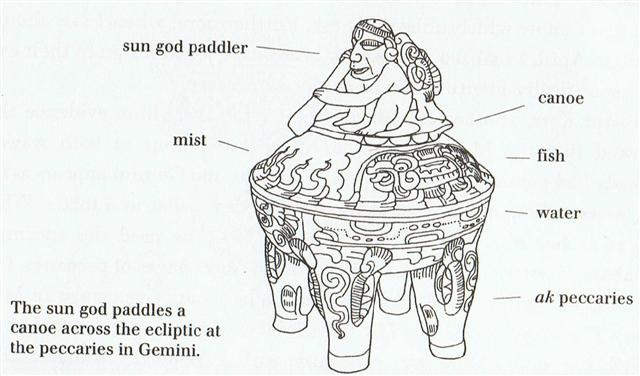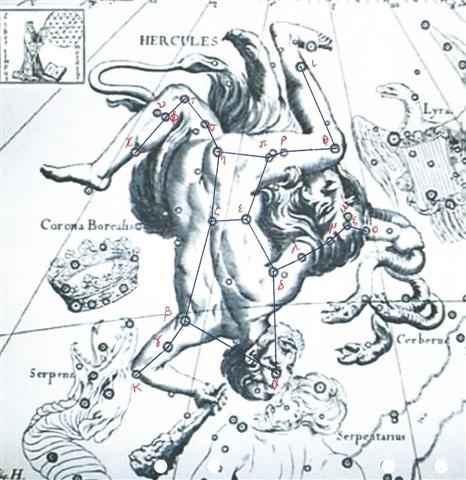This point is driven home at the
beginning of the G text, where there is
no glyph corresponding to the first day:
The G text measures 472 days, but day zero
cannot be visualized:

|
a1 |
30 |
30 |
b1 |
26 |
26 |
|
a2 |
29 |
59 |
b2 |
35 |
61 |
|
a3 |
24 |
83 |
b3 |
30 |
91 |
|
a4 |
27 |
110 |
b4 |
33 |
124 |
|
a5 |
30 |
140 |
b5 |
29 |
153 |
|
a6 |
29 |
169 |
b6 |
28 |
181 |
|
a7 |
34 |
203 |
b7 |
31 |
212 |
|
a8 |
26 |
229 |
b8 |
30 |
242 |
|
sum |
229 |
sum |
242 |
|
(1 + 229) + 242 = 472 =
16 * 29½ |
The first side should therefore be counted as 230
right ascension days.
Similarly should we add 1 day before the 1st
glyph in the C text, but here presumably
also on side b - in order to
avoid an odd total:
|
a1 |
26 |
26 |
b1 |
24 |
24 |
|
a2 |
25 |
51 |
b2 |
25 |
49 |
|
a3 |
25 |
76 |
b3 |
22 |
71 |
|
a4 |
29 |
105 |
b4 |
23 |
94 |
|
a5 |
35 |
140 |
b5 |
21 |
115 |
|
a6 |
28 |
168 |
b6 |
29 |
144 |
|
a7 |
31 |
199 |
b7 |
27 |
171 |
|
a8 |
29 |
228 |
b8 |
29 |
200 |
|
a9 |
27 |
255 |
b9 |
30 |
230 |
|
a10 |
29 |
284 |
b10 |
22 |
252 |
|
a11 |
32 |
316 |
b11 |
22 |
274 |
|
a12 |
27 |
343 |
b12 |
25 |
299 |
|
a13 |
20 |
363 |
b13 |
30 |
329 |
|
a14 |
29 |
392 |
b14 |
19 |
348 |
|
sum |
392 |
sum |
348 |
|
(1 + 392) + (1 + 348) = 742
=
14 * 53 |
And of course it means we should count
also the B text accordingly:
|
a1 |
47 |
47 |
b1 |
31 |
31 |
|
a2 |
40 |
87 |
b2 |
47 |
78 |
|
a3 |
37 |
124 |
b3 |
43 |
121 |
|
a4 |
40 |
164 |
b4 |
42 |
163 |
|
a5 |
43 |
207 |
b5 |
40 |
203 |
|
a6 |
44 |
251 |
b6 |
40 |
243 |
|
a7 |
43 |
294 |
b7 |
41 |
284 |
|
a8 |
46 |
340 |
b8 |
42 |
326 |
|
a9 |
49 |
389 |
b9 |
50 |
376 |
|
a10 |
32 |
421 |
b10 |
42 |
418 |
|
|
b11 |
43 |
461 |
|
b12 |
45 |
506 |
|
sum |
421 |
sum |
506 |
|
(1 + 421) + 506 = 928 = 2
* 464 =
29 * 32 |
|
No
glyph (0) |
 |
 |
 |
 |
 |
407 |
|
Ba1-1 (927 + 1) |
Ba1-2 |
Ba1-3 |
Ba1-4 |
Ba1-5 |
|
SIRRAH (0h) |
ALGENIB PEGASI |
*2 |
*3 |
*4 |
ANKAA (*5) |
|
ALCHITA (*183) |
*184 |
GIENAH (*185) |
*186 |
ACRUX (*187) |
*188 |
|
e tagata haga era ki te
mea ke |
8 |
koia kua here i to reva
ika - kua huka ia - i to
maro |
65 |
e tagata itiiti mea mau -
i te vaha |
|
 |
 |
 |
 |
|
Ba10-24 (413) |
Bb1-1 (422 = 322 + 100) |
Bb1-2 |
Bb2-37 (68) |
|
ZIBAL (*413 = *48) |
MENKHIB
(*422 = *57) |
ZAURAK (*58) |
AL TARF (*489 = *124) |
|
FEBR 17 (413) |
FEBR 26 (422) |
27 (58) |
MAY 4
(124) |
|
April 22 (*32 = *48 - *16) |
May 1 (*41 = *57 - *16) |
2 (*241 - *199 = *42) |
July 7 (*307 - *199 = *108) |
|
*231 = *413 - *182 |
*240 = *57 + *183 |
*241 = *42 + *183 + *16 |
GREDI (*307) |
We can be compare with the beginning
of the C text where, however, it
evidently was the
Sun who was
reaching the Raven:
|
No glyph |
koia |
ki te
hoea |
ki te henua |
te rima te hau tea |
haga i te mea ke |
ki te henua - tagata
honui |
|
Ko.
1. Article (ko te);
preposition: with (see
grammar); prefix of personal
pronouns: koau, I;
kokoe, you (singular);
koîa, he, she, it;
kokorua, you (plural);
ko tagi, koîa, he
with his weeping. 2. Article
which precedes proper nouns,
often also used with place
names: Ko Tori, Ko Hotu
Matu'a, Ko Pú.
Koîa, exact: tita'a
koîa, exact demarcation.
Seems to be the personal
pronoun koîa -
applied in the meaning of:
thus it is, here it is
precisely. Vanaga. 1.
Negative; e ko, not,
except; e ko ora,
incurable; ina ko,
not; ina ko tikea,
unseen; ina e ko,
not; ina e ko mou,
incessant. 2. A particle
used before nouns and
pronouns; ko vau, I;
ko te, this; ko
mea tera, this; ati
ko peka, to avenge,
ko mua, first, at first,
formerly. 3. There, yonder.
P Mgv.: ko, over
there, yonder. Ta.: ó,
there, here. Churchill.
...
Before the beginning of a
new 'year' (= halfyear) it
is not yet determined what
will come. According to the
Babylonian view there was a
chamber of hazard where the
sky roof meets earth:
... Als solch ein Ort (resp.
ein Gemach) im Osten des
apsū [water below the
earth] und im Osten der Erde
an der Grenze zwischen dem
sichtbaren und unsichtbaren
Reiche hat der Duazag
eine ganz besondere
Bedeutung im Glauben der
Babylonier. Er ist ... 'der
Ort der Geschicke', der
ki nam-tar-tar-ini =
ašar šimātum. Ein
Solcher konnte nur im Osten
liegen. Denn die Sonne geht
im Osten auf.
Die
Ostsonne ist Marduk.
Darum bringt auch Marduk
die Geschicke aus der
Behausung seines Vaters
Ía, dem Urwasser, hervor
...
Hoe. Hoe
1. Paddle. Mgv.: hoe,
ohe, id. Mq., Ta.:
hoe, id. 2. To wheeze
with fatigue (oeoe
2). Arero oeoe, to
stammer, to stutter; Mgv.
oe, to make a whistling
sound in breathing; ohe,
a cry from a person out of
breath. Mq.: oe, to
wheeze with fatigue. 3.
Blade, knife; hoe
hakaiu, clasp-knife,
jack-knife; hoe hakanemu,
clasp-knife; hoe pikopiko,
pruning knife. 4. Ta.:
oheohe, a plant. Ma.:
kohekohe, id.
Churchill.T. Paddle. E
hoe te heiva = 'and to
paddle (was their)
pleasure'. Henry. Hoea,
instrument for tattooing.
Barthel.
 |
 |
 |
 |
 |
 |
 |
|
Ca1-1 |
Ca1-2 |
Ca1-3 |
Ca1-4 |
Ca1-5 |
Ca1-6 |
|
CLOSE TO THE SUN: |
|
Sept 20 (263) |
21 |
Equinox |
23 (181 + 85) |
24 |
25 (84
+ 184) |
26 |
|
ALCHITA = α Corvi, MA WEI
(Tail of the Horse) = δ
Centauri
(183.1),
MINKAR = ε Corvi
(183.7), ρ Centauri (183.9) |
PÁLIDA (Pale) = δ Crucis
(184.6),
MEGREZ (Root of the Tail) =
δ Ursae Majoris
(184.9) |
Hasta-13 (Hand) /
Chariot-28 (Worm)
GIENAH (Wing) = γ Corvi
(185.1),
ε
Muscae (185.2),
ζ Crucis (185.4),
ZANIAH (Corner) = η Virginis
(185.9)
*144.0 = *185.4 - *41.4 |
CHANG SHA (Long Sand-bank) =
ζ Corvi
(186.3) |
INTROMETIDA (Inserted) = ε
Crucis (187.4), ACRUX = α
Crucis
(187.5)
*146.0 = *187.4 - *41.4 |
γ
Com. Berenicis (188.0),
σ
Centauri (188.1),
ALGORAB = δ Corvi (188.5),
GACRUX = γ Crucis
(188.7) |
γ
Muscae (189.0),
AVIS SATYRA (Bird of the
Satyrs) = η Corvi
(189.3),
ASTERION (Starry) = β Canum
Ven.
(189.5),
KRAZ = β Corvi,
κ Draconis (189.7) |

... Raven gazed up and down
the beach. It was pretty,
but lifeless. There was no
one about to upset, or play
tricks upon. Raven sighed.
He crossed his wings behind
him and strutted up and down
the sand, his shiny head
cocked, his sharp eyes and
ears alert for any unusual
sight or sound. The
mountains and the sea, the
sky now ablaze with the sun
by day and the moon and
stars he had placed there,
it was all pretty, but
lifeless. Finally Raven
cried out to the empty sky
with a loud exasperated cry.
And before the echoes of his
cry faded from the shore, he
heard a muffled squeak. He
looked up and down the beach
for its source and saw
nothing. He strutted back
and and forth, once, twice,
three times and still saw
nothing. Then he spied a
flash of white in the sand.
There, half buried in the
sand was a giant clamshell.
As his shadow fell upon it,
he heard another muffled
squeak. Peering down into
the opening between the
halves of the shell, he saw
it was full of tiny
creatures, cowering in fear
at his shadow ... |
|
CLOSE TO THE FULL MOON: |
|
March 21 (80)
Al Fargh al Thāni-25 (Rear
Spout)
0h (365.25)
CAPH (Hand) = β Cassiopeiae,
SIRRAH (Navel of the Horse)
= α Andromedae
(0.5),
ε
Phoenicis,
γ³
Oct.
(0.8) |
22
Uttara Bhādrapadā-27 (2nd of
the Blessed Feet) /
Wall-14 (Porcupine)
ο Oct. (1.3),
ALGENIB PEGASI = γ
Pegasi
(1.8) |
23
χ Pegasi (2.1), θ Andromedae
(2.7) |
24
σ Andromedae (3.0), ι Ceti
(3.3), ζ Tucanae (3.5), ρ
Andromedae, π Tucanae (3.7) |
Julian
equinox
No
star listed (4) |
26 (80 + 5)
ANKAA = α Phoenicis,
κ Phoenicis (5.0)
ALPHARD
(α Hydrae)
|
27
λ Phoenicis (6.3),
β Tucanae (6.4)
*6.4 - *41.4 + *366.0 = *331
= *148.0 + 183.0 |
|
... Nut,
whom the Greeks sometimes
identified with Rhea, was
goddess of the sky, but it
was debatable if in
historical times she was the
object of a genuine cult.
She was Geb's twin sister
and, it was said, married
him secretly and against the
will of Ra. Angered, Ra had
the couple brutally
separated by Shu and
afterwards decreed that Nut
could not bear a child in
any given month of any year.
Thoth, Plutarch tells us,
happily had pity on her.
Playing draughts with the
Moon, he won in the course
of several games a
seventy-second part of the
Moon's light with which he
composed five new days. As
these five intercalated days
did not belong to the
official Egyptian calendar
of three hundred and sixty
days, Nut was thus able to
give birth successively to
five children: Osiris,
Haroeris (Horus), Set, Isis
and Nepthys ... |

... The
players all played at once,
without waiting for turns,
quarreling all the while,
and fighting for the
hedge-hogs; and in a very
short time the Queen was in
a furious passion, and went
stamping about, and shouting
'Off with his head!' or 'Off
with her head!' about once
in a minute. Alice began to
feel very uneasy: to be
sure, she had not as yet had
any dispute with the Queen,
but she knew that it might
happen any minute, 'and
then', thought she, 'what
would become of me?' They're
dreadfully fond of beheading
people here: the great
wonder is, that there's any
one left alive! ... |
When the water (tide) went out it
was as if land had been drawned up (like
a fish) from the deep.
... The brothers
had no idea what Maui was up to now,
as he paid out his line. Down, down
it sank, and when it was at the
bottom Maui lifted it slightly, and
it caught on something which at once
pulled very hard. Maui pulled also,
and hauled in a little of his line.
The canoe heeled over, and was
shipping water fast. 'Let it go!'
cried the frightened brothers, but
Maui answered with the words that
are now a proverb: 'What Maui has
got in his hand he cannot throw
away.' 'Let go?' he cried. 'What did
I come for but to catch fish?' And
he went on hauling in his line, the
canoe kept taking water, and his
brothers kept bailing frantically,
but Maui would not let go. Now
Maui's hook had caught in the
barge-boards of the house of
Tonganui, who lived at the bottom of
that part of the sea and whose name
means Great South; for it was as far
to the south that the brothers had
paddled from their home. And Maui
knew what it was that he had caught,
and while he hauled at his line he
was chanting the spell that goes: O
Tonganui / why do you hold so
stubbornly there below? // The power
of Muri's jawbone is at work on you,
/ you are coming, / you are caught
now, / you are coming up, / appear,
appear. // Shake yourself, /
grandson of Tangaroa the little. The
fish came near the surface then, so
that Maui's line was slack for a
moment, and he shouted to it not to
get tangled. But then the fish
plunged down again, all the way to
the bottom. And Maui had to strain,
and haul away again. And at the
height of all this excitement his
belt worked loose, and his maro
fell off and he had to kick it from
his feet. He had to do the rest with
nothing on ...
From July 11 (→
7-11 → Ga7-11) → Cancer (λ)
at day 181 + 11 = 192

to day 280 (40 weeks) there were 280 -
192 = 88 days.
|
APRIL 14 (104 = 4 * 22 + 16 = 2
* 52) |
155 |
SEPT 17 (260) |
11 |
SEPT 29 (272 = 4 * 64 + 16 = 4
* 68) |
7 |
OCT 7 (280) |
|
 |
 |
 |
 |
|
Ga1-24 |
Ga7-11
(180) |
Ga7-23 (192) |
Ga7-31 (200) |
|
June 17 (168 = 2 * 84) |
Nov 20 (*244) |
Dec 2 (336 = 4 * 84) |
Dec 10 (*264) |
|
BETELGEUZE (*88) |
ν Scorpii |
CUJAM (*256) |
υ (325) Scorpii |
|
157 = 314 / 2 |
20 = 420 / 21 |
|
177 = 6 * 29½ = 472 - 295
|
Cujam (ε
Herculi) was said to be the Club of Hercules:


... The last of these stars to rise
in the 17th hour (ε)
has the same name as ω, viz.
Kajam, but in order to
distinguish between them I named it
Cujam (the name Kajam
already having been used for ω in my
astronomy book):
ω, a
4th magnitude double, by some early
transcriber's error, is now given as
Cujam, from Caiam, the
accusative of Caia, the word used by
Horace for the Club of Hercules,
which is marked by this star.
Gaiam, Guiam, and
Guyam, frequently seen, are
erroneous. In Burritt's Atlas
the star is wrongly placed within
the uplifted right arm. The Club
of Hercules is supposed to have
been a separate constellation with
Pliny ...

|




















